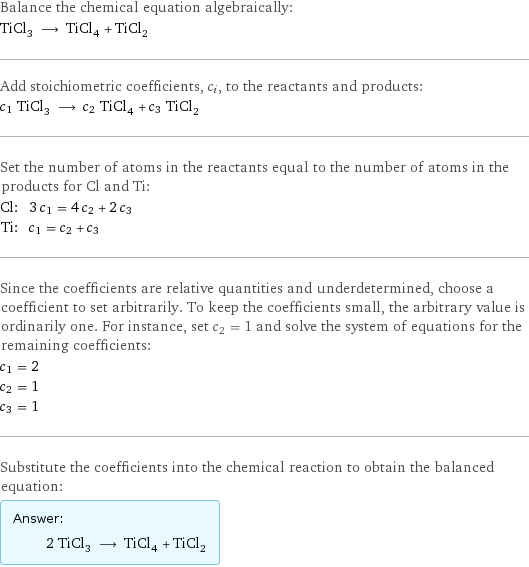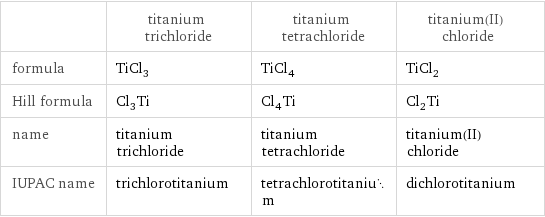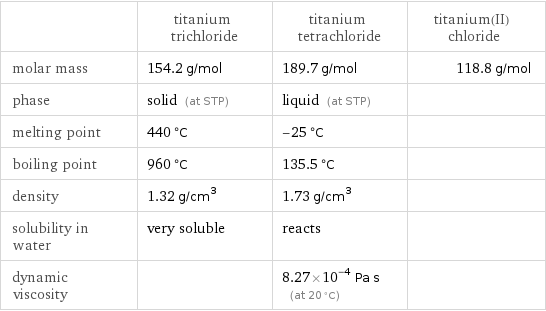Input interpretation

TiCl_3 titanium trichloride ⟶ TiCl_4 titanium tetrachloride + TiCl_2 titanium(II) chloride
Balanced equation

Balance the chemical equation algebraically: TiCl_3 ⟶ TiCl_4 + TiCl_2 Add stoichiometric coefficients, c_i, to the reactants and products: c_1 TiCl_3 ⟶ c_2 TiCl_4 + c_3 TiCl_2 Set the number of atoms in the reactants equal to the number of atoms in the products for Cl and Ti: Cl: | 3 c_1 = 4 c_2 + 2 c_3 Ti: | c_1 = c_2 + c_3 Since the coefficients are relative quantities and underdetermined, choose a coefficient to set arbitrarily. To keep the coefficients small, the arbitrary value is ordinarily one. For instance, set c_2 = 1 and solve the system of equations for the remaining coefficients: c_1 = 2 c_2 = 1 c_3 = 1 Substitute the coefficients into the chemical reaction to obtain the balanced equation: Answer: | | 2 TiCl_3 ⟶ TiCl_4 + TiCl_2
Structures

⟶ +
Names

titanium trichloride ⟶ titanium tetrachloride + titanium(II) chloride
Equilibrium constant
![Construct the equilibrium constant, K, expression for: TiCl_3 ⟶ TiCl_4 + TiCl_2 Plan: • Balance the chemical equation. • Determine the stoichiometric numbers. • Assemble the activity expression for each chemical species. • Use the activity expressions to build the equilibrium constant expression. Write the balanced chemical equation: 2 TiCl_3 ⟶ TiCl_4 + TiCl_2 Assign stoichiometric numbers, ν_i, using the stoichiometric coefficients, c_i, from the balanced chemical equation in the following manner: ν_i = -c_i for reactants and ν_i = c_i for products: chemical species | c_i | ν_i TiCl_3 | 2 | -2 TiCl_4 | 1 | 1 TiCl_2 | 1 | 1 Assemble the activity expressions accounting for the state of matter and ν_i: chemical species | c_i | ν_i | activity expression TiCl_3 | 2 | -2 | ([TiCl3])^(-2) TiCl_4 | 1 | 1 | [TiCl4] TiCl_2 | 1 | 1 | [TiCl2] The equilibrium constant symbol in the concentration basis is: K_c Mulitply the activity expressions to arrive at the K_c expression: Answer: | | K_c = ([TiCl3])^(-2) [TiCl4] [TiCl2] = ([TiCl4] [TiCl2])/([TiCl3])^2](../image_source/d01d187cfd7fcc92006f5ce9b9f5fcb9.png)
Construct the equilibrium constant, K, expression for: TiCl_3 ⟶ TiCl_4 + TiCl_2 Plan: • Balance the chemical equation. • Determine the stoichiometric numbers. • Assemble the activity expression for each chemical species. • Use the activity expressions to build the equilibrium constant expression. Write the balanced chemical equation: 2 TiCl_3 ⟶ TiCl_4 + TiCl_2 Assign stoichiometric numbers, ν_i, using the stoichiometric coefficients, c_i, from the balanced chemical equation in the following manner: ν_i = -c_i for reactants and ν_i = c_i for products: chemical species | c_i | ν_i TiCl_3 | 2 | -2 TiCl_4 | 1 | 1 TiCl_2 | 1 | 1 Assemble the activity expressions accounting for the state of matter and ν_i: chemical species | c_i | ν_i | activity expression TiCl_3 | 2 | -2 | ([TiCl3])^(-2) TiCl_4 | 1 | 1 | [TiCl4] TiCl_2 | 1 | 1 | [TiCl2] The equilibrium constant symbol in the concentration basis is: K_c Mulitply the activity expressions to arrive at the K_c expression: Answer: | | K_c = ([TiCl3])^(-2) [TiCl4] [TiCl2] = ([TiCl4] [TiCl2])/([TiCl3])^2
Rate of reaction
![Construct the rate of reaction expression for: TiCl_3 ⟶ TiCl_4 + TiCl_2 Plan: • Balance the chemical equation. • Determine the stoichiometric numbers. • Assemble the rate term for each chemical species. • Write the rate of reaction expression. Write the balanced chemical equation: 2 TiCl_3 ⟶ TiCl_4 + TiCl_2 Assign stoichiometric numbers, ν_i, using the stoichiometric coefficients, c_i, from the balanced chemical equation in the following manner: ν_i = -c_i for reactants and ν_i = c_i for products: chemical species | c_i | ν_i TiCl_3 | 2 | -2 TiCl_4 | 1 | 1 TiCl_2 | 1 | 1 The rate term for each chemical species, B_i, is 1/ν_i(Δ[B_i])/(Δt) where [B_i] is the amount concentration and t is time: chemical species | c_i | ν_i | rate term TiCl_3 | 2 | -2 | -1/2 (Δ[TiCl3])/(Δt) TiCl_4 | 1 | 1 | (Δ[TiCl4])/(Δt) TiCl_2 | 1 | 1 | (Δ[TiCl2])/(Δt) (for infinitesimal rate of change, replace Δ with d) Set the rate terms equal to each other to arrive at the rate expression: Answer: | | rate = -1/2 (Δ[TiCl3])/(Δt) = (Δ[TiCl4])/(Δt) = (Δ[TiCl2])/(Δt) (assuming constant volume and no accumulation of intermediates or side products)](../image_source/21497954efbd9c6a9ea97f89a0927031.png)
Construct the rate of reaction expression for: TiCl_3 ⟶ TiCl_4 + TiCl_2 Plan: • Balance the chemical equation. • Determine the stoichiometric numbers. • Assemble the rate term for each chemical species. • Write the rate of reaction expression. Write the balanced chemical equation: 2 TiCl_3 ⟶ TiCl_4 + TiCl_2 Assign stoichiometric numbers, ν_i, using the stoichiometric coefficients, c_i, from the balanced chemical equation in the following manner: ν_i = -c_i for reactants and ν_i = c_i for products: chemical species | c_i | ν_i TiCl_3 | 2 | -2 TiCl_4 | 1 | 1 TiCl_2 | 1 | 1 The rate term for each chemical species, B_i, is 1/ν_i(Δ[B_i])/(Δt) where [B_i] is the amount concentration and t is time: chemical species | c_i | ν_i | rate term TiCl_3 | 2 | -2 | -1/2 (Δ[TiCl3])/(Δt) TiCl_4 | 1 | 1 | (Δ[TiCl4])/(Δt) TiCl_2 | 1 | 1 | (Δ[TiCl2])/(Δt) (for infinitesimal rate of change, replace Δ with d) Set the rate terms equal to each other to arrive at the rate expression: Answer: | | rate = -1/2 (Δ[TiCl3])/(Δt) = (Δ[TiCl4])/(Δt) = (Δ[TiCl2])/(Δt) (assuming constant volume and no accumulation of intermediates or side products)
Chemical names and formulas

| titanium trichloride | titanium tetrachloride | titanium(II) chloride formula | TiCl_3 | TiCl_4 | TiCl_2 Hill formula | Cl_3Ti | Cl_4Ti | Cl_2Ti name | titanium trichloride | titanium tetrachloride | titanium(II) chloride IUPAC name | trichlorotitanium | tetrachlorotitanium | dichlorotitanium
Substance properties

| titanium trichloride | titanium tetrachloride | titanium(II) chloride molar mass | 154.2 g/mol | 189.7 g/mol | 118.8 g/mol phase | solid (at STP) | liquid (at STP) | melting point | 440 °C | -25 °C | boiling point | 960 °C | 135.5 °C | density | 1.32 g/cm^3 | 1.73 g/cm^3 | solubility in water | very soluble | reacts | dynamic viscosity | | 8.27×10^-4 Pa s (at 20 °C) |
Units
